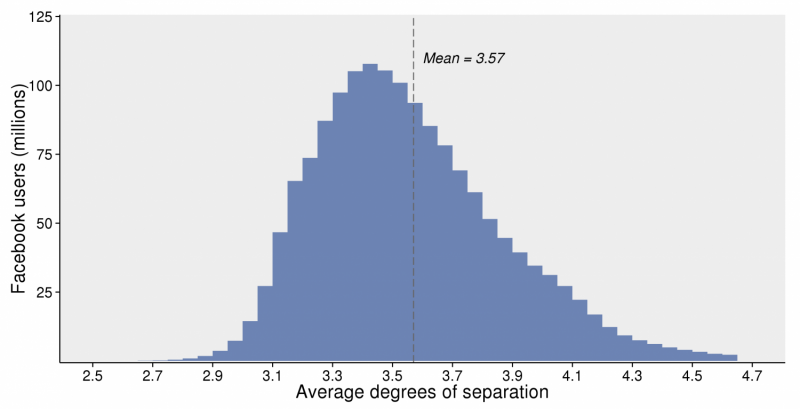February 6, 2016 weblog
Facebook blog explains cut in six degrees of separation

Hop, hop, hop and you're in a connection with somebody else. Strange notion but Facebook researchers have been crunching numbers. They found that the six degrees of separation theory where everyone and everything is six or fewer steps away are actually less.
For years, imaginations have taken flight with the intoxicating concept defying barriers of all types. The number "six" has been accepted as the working number.
However, never tell connection-hungry researchers at Facebook to swallow a number without checking. They found it was less.
How they worked it out: They used statistical techniques to estimate distance based on de-identified, aggregate data. They said they turned to statistical algorithms developed by Kang and others to estimate distances. They estimated the number of distinct people you can reach from every source. using the Flajolet-Martin algorithm; they used Apache Giraph to run computations on the entire Facebook friendship graph.
"In honor of Friends Day, we've crunched the Facebook friend graph and determined that the number is 3.57." They turned to their 1.59 billion people active on Facebook. and found that the connection was such that each person in the world (yes, the world) was connected to every other person by an average of three and a half other people. (The average person is connected to every other person by an average of 3.57 steps and the majority of people have an average between 3 and 4 steps.)
Considering this is 2016, the numerical cut seems explainable. Think Internet. Think social networks. Land on Facebook.
"Our collective 'degrees of separation' have shrunk over the past five years," they wrote. "In 2011, researchers at Cornell, the Università degli Studi di Milano, and Facebook computed the average across the 721 million people using the site then, and found that it was 3.74. Now, with twice as many people using the site, we've grown more interconnected, thus shortening the distance between any two people in the world."
Sergey Edunov, Carlos Diuk, Ismail Onur Filiz, Smriti Bhagat and Moira Burke wrote those words, in a Thursday blog on Research at Facebook with their title as "Three and a Half Degrees of Separation."
But wait a minute. If we're talking numbers, Shawn Knight asked for a pause. Writing in TechSpot, he said "It's an interesting bit of math for sure but it's also a bit misleading." Look at their subjects. "Facebook's sample size of 1.59 billion people – the number of people that use the social network – is far smaller than the 7.4 billion people that currently inhabit our blue planet."
Another issue is its being a "curated sample of people with Internet access that want a Facebook account – in other words, a group of people that have things in common, thus increasing the likelihood that they'll be connected." Knight pointed out that in the original concept a person was connected to everyone else by not more than six acquaintances, not friends.
Lawrence Lewitinn in Yahoo Finance also took up the discussion: "A piece missing in this study is that 5.8 billion people are NOT on Facebook. So the study's sample is just among those who have the ability and likelihood to join Facebook in the first place."
More information: research.facebook.com/blog/thr … grees-of-separation/
© 2016 Tech Xplore




















